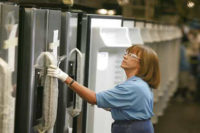National Archives Exhibition Explores Labor History
WASHINGTON-Work and the workplace have gone through enormous changes between the mid-19th century, when 60 percent of Americans made their living as farmers, and the late 20th century. A new traveling exhibition, “The Way We Worked,” features 86 photographs from the National Archives focusing on the history of work in America and documenting work clothing, locales, conditions and conflicts. The exhibition opened March 10 in Georgia and will remain on tour, visiting 14 cities around the country, through 2010.
As the depository for historically valuable federal records, the National Archives is home to thousands of photographs of work and workplaces taken by government agencies to investigate factory safety, track construction progress or emphasize the continuing importance of humans in a technologically modern environment. The images featured in “The Way We Worked,” though possibly taken merely for purposes of record keeping, often reveal much more about how social forces such as immigration, gender, ethnicity, class, and technology have transformed the workforce.
The exhibition is divided into five sections: Where We Worked, How We Worked, What We Wore to Work, Conflict at Work and Dangerous or Unhealthy Work, featuring many of the photographs taken by social reformers hoping to ban child labor, reduce the length of the work day and expose unsanitary workplaces. For additional information, including a tour schedule, visitwww.archives.gov.

